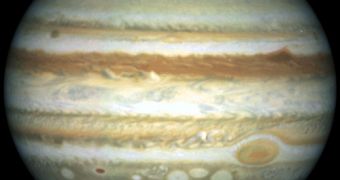Extrasolar planets are very hard to find, because light bouncing off these planets is easily lost in the sea of brightness generated by the star around which it orbits. It's kind of like searching for a firefly next to a lighthouse lamp.
All in all, astronomers have found about 230 extrasolar planets beyond our own solar system and just last week announced the discovery of an Earth-like planet that has liquid water and could support life.
Now they announced the discovery of the densest planet outside our solar planet, a strange alien world only slightly bigger that our Jupiter, but having more that eight times its weight.
It's been named HAT-P-2b, and it's the most massive super-dense planet orbiting a star. The gas giant orbits the star HD 147506, in the constellation Hercules, which is only a bit hotter that our Sun and around twice its size.
Astronomer Gaspar Bakos, led the team at the Harvard-Smithsonian Center for Astrophysics, who made the discovery, said that "This planet is so unusual that at first we thought it was a false alarm - something that appeared to be a planet but wasn't. But we eliminated every other possibility, so we knew we had a really weird planet."
It is indeed a usual planet. It has a revolution period (rotation around its star) of only five and a half days, but in this time, due to the fact that is has an elliptical trajectory, it first gets very close to the star, about 3.1 million miles (4.9 million kilometers), thus baking its surface and then gets to a considerable distance from it, about 9.6 million miles (15.4 million kilometers) which cools it again.
As a comparison, Earth has the distance to the Sun of 93 million miles (150 million kilometers), which means that the giant would range between the orbits of Mercury and Mars, if it were in Earth's place in space.
During the transit (when the planet comes in front of its star), scientists can determine the physical size of extrasolar planet by measuring how much it dims the light of the central star.
The astronomers found that the newly discovered planet is about 1.18 times brighter than Jupiter and 8.2 times as massive. That means that its gravitational pull, 14 times stronger than Earth's would make a person weighing 150 pounds (60 kilograms) on Earth weigh 2,100 pounds (952 kilograms), at the visible cloud top surface of HAT-P-2b.
If the super-dense planet had contained around 50 percent more mass that it presently does, it would have been able to start nuclear fusion, thus burning as a star for a short while.

 14 DAY TRIAL //
14 DAY TRIAL //